Final Journal: Reflecting on My Leadership Style and Effectiveness
VerifiedAdded on 2020/03/02
|8
|1824
|37
Journal and Reflective Writing
AI Summary
This final journal entry provides a comprehensive self-reflection on the student's leadership style and its impact. The student explores their preferred participative leadership style, acknowledging its time-consuming nature and contrasting it with autocratic approaches. The journal details the student's self-perception as a charismatic leader, comparing it to the views of a discussion partner and identifying both similarities and differences. The student analyzes the effects of their leadership style on others, including potential challenges related to time management and information sharing, and outlines strategies to minimize weaknesses. The journal also considers potential obstacles to achieving leadership goals, such as resistant individuals and conflicting personal agendas, while emphasizing the importance of adaptability and transformational leadership. Overall, the journal offers a critical assessment of the student's leadership journey, drawing on theoretical concepts and personal experiences to identify areas for improvement and future development.
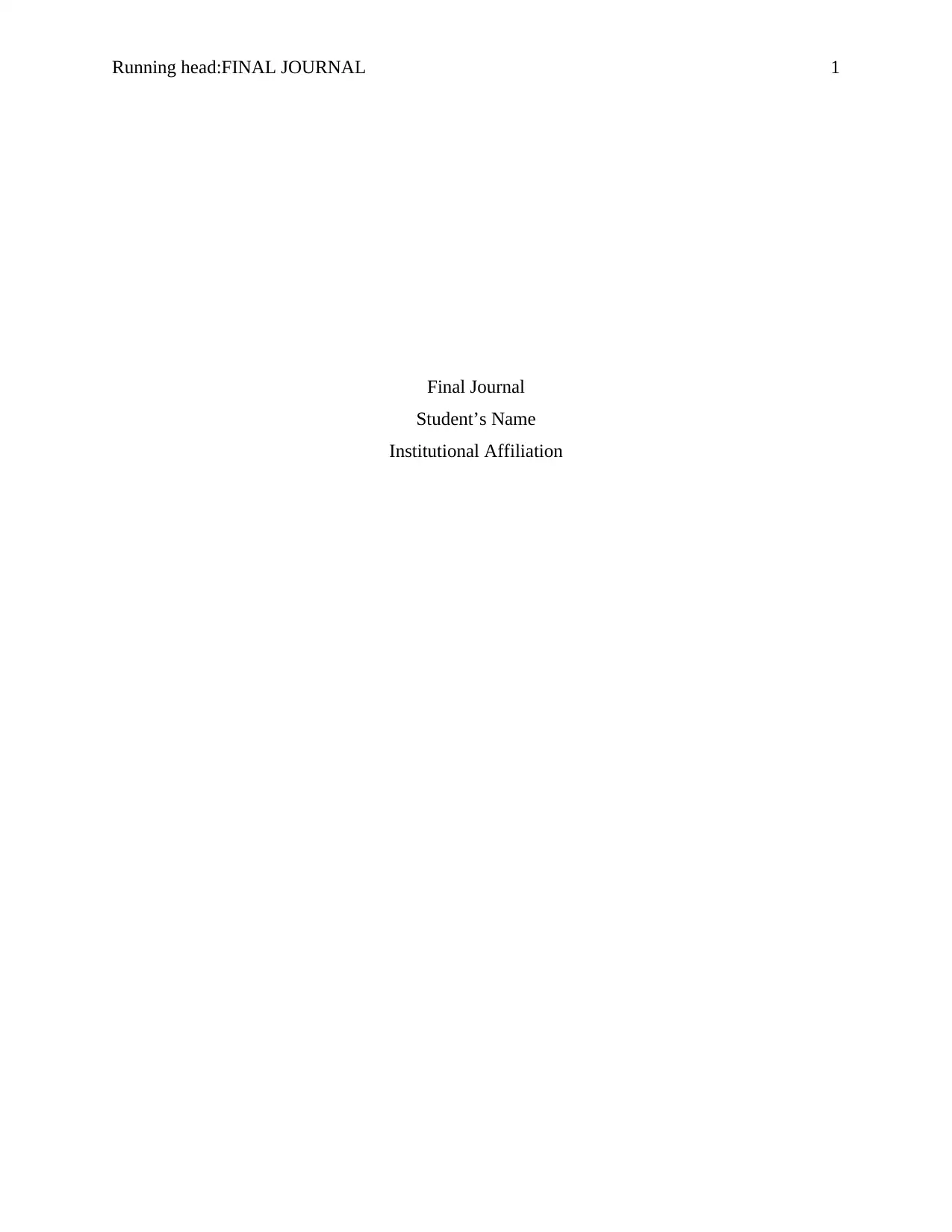
Running head:FINAL JOURNAL 1
Final Journal
Student’s Name
Institutional Affiliation
Final Journal
Student’s Name
Institutional Affiliation
Paraphrase This Document
Need a fresh take? Get an instant paraphrase of this document with our AI Paraphraser
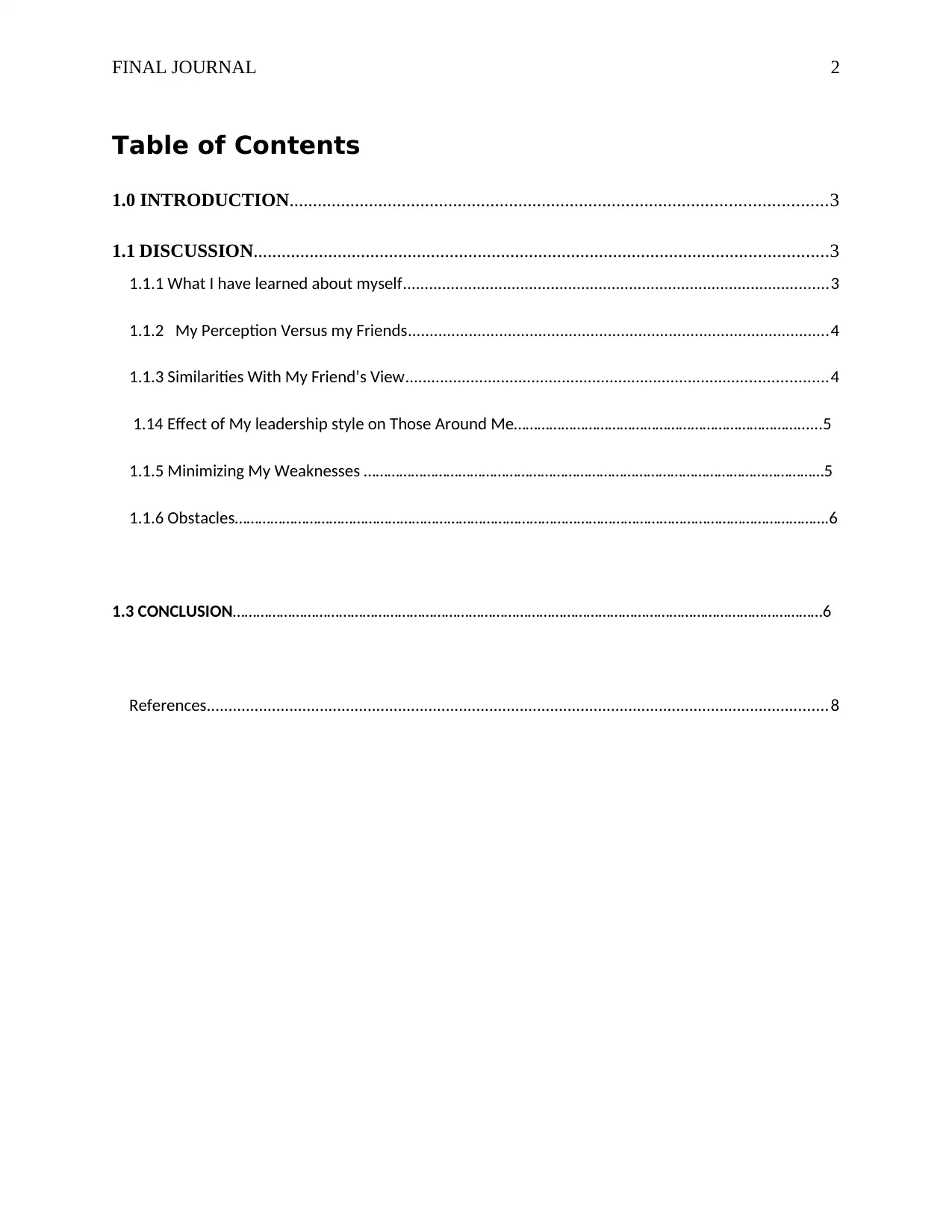
FINAL JOURNAL 2
Table of Contents
1.0 INTRODUCTION...................................................................................................................3
1.1 DISCUSSION...........................................................................................................................3
1.1.1 What I have learned about myself..................................................................................................3
1.1.2 My Perception Versus my Friends.................................................................................................4
1.1.3 Similarities With My Friend’s View.................................................................................................4
1.14 Effect of My leadership style on Those Around Me………………………………………………………………......5
1.1.5 Minimizing My Weaknesses ………………………………………………………………………………………………………5
1.1.6 Obstacles…………………………………………………………………………………………………………………………………….6
1.3 CONCLUSION……………………………………………………………………………………………………………………………………6
References...............................................................................................................................................8
Table of Contents
1.0 INTRODUCTION...................................................................................................................3
1.1 DISCUSSION...........................................................................................................................3
1.1.1 What I have learned about myself..................................................................................................3
1.1.2 My Perception Versus my Friends.................................................................................................4
1.1.3 Similarities With My Friend’s View.................................................................................................4
1.14 Effect of My leadership style on Those Around Me………………………………………………………………......5
1.1.5 Minimizing My Weaknesses ………………………………………………………………………………………………………5
1.1.6 Obstacles…………………………………………………………………………………………………………………………………….6
1.3 CONCLUSION……………………………………………………………………………………………………………………………………6
References...............................................................................................................................................8
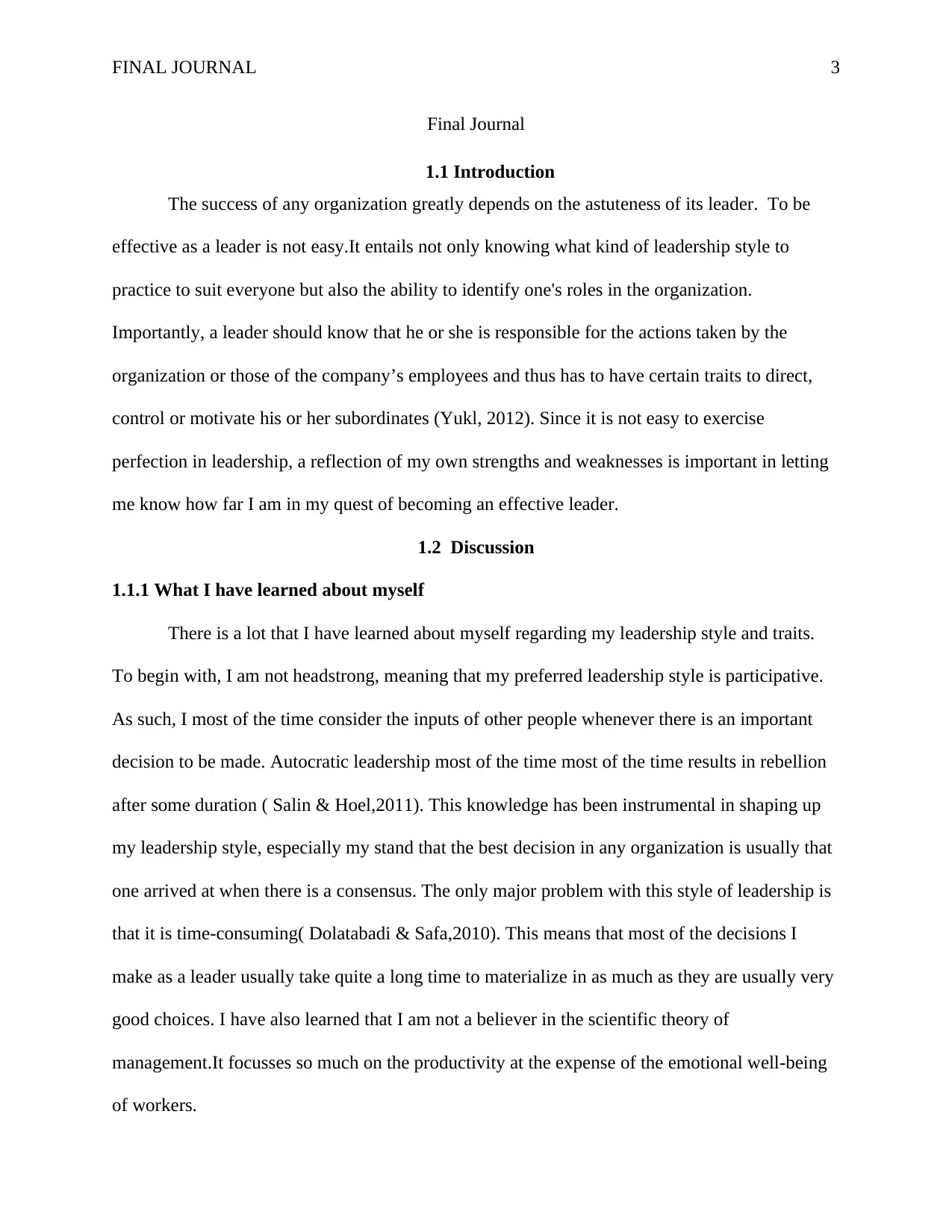
FINAL JOURNAL 3
Final Journal
1.1 Introduction
The success of any organization greatly depends on the astuteness of its leader. To be
effective as a leader is not easy.It entails not only knowing what kind of leadership style to
practice to suit everyone but also the ability to identify one's roles in the organization.
Importantly, a leader should know that he or she is responsible for the actions taken by the
organization or those of the company’s employees and thus has to have certain traits to direct,
control or motivate his or her subordinates (Yukl, 2012). Since it is not easy to exercise
perfection in leadership, a reflection of my own strengths and weaknesses is important in letting
me know how far I am in my quest of becoming an effective leader.
1.2 Discussion
1.1.1 What I have learned about myself
There is a lot that I have learned about myself regarding my leadership style and traits.
To begin with, I am not headstrong, meaning that my preferred leadership style is participative.
As such, I most of the time consider the inputs of other people whenever there is an important
decision to be made. Autocratic leadership most of the time most of the time results in rebellion
after some duration ( Salin & Hoel,2011). This knowledge has been instrumental in shaping up
my leadership style, especially my stand that the best decision in any organization is usually that
one arrived at when there is a consensus. The only major problem with this style of leadership is
that it is time-consuming( Dolatabadi & Safa,2010). This means that most of the decisions I
make as a leader usually take quite a long time to materialize in as much as they are usually very
good choices. I have also learned that I am not a believer in the scientific theory of
management.It focusses so much on the productivity at the expense of the emotional well-being
of workers.
Final Journal
1.1 Introduction
The success of any organization greatly depends on the astuteness of its leader. To be
effective as a leader is not easy.It entails not only knowing what kind of leadership style to
practice to suit everyone but also the ability to identify one's roles in the organization.
Importantly, a leader should know that he or she is responsible for the actions taken by the
organization or those of the company’s employees and thus has to have certain traits to direct,
control or motivate his or her subordinates (Yukl, 2012). Since it is not easy to exercise
perfection in leadership, a reflection of my own strengths and weaknesses is important in letting
me know how far I am in my quest of becoming an effective leader.
1.2 Discussion
1.1.1 What I have learned about myself
There is a lot that I have learned about myself regarding my leadership style and traits.
To begin with, I am not headstrong, meaning that my preferred leadership style is participative.
As such, I most of the time consider the inputs of other people whenever there is an important
decision to be made. Autocratic leadership most of the time most of the time results in rebellion
after some duration ( Salin & Hoel,2011). This knowledge has been instrumental in shaping up
my leadership style, especially my stand that the best decision in any organization is usually that
one arrived at when there is a consensus. The only major problem with this style of leadership is
that it is time-consuming( Dolatabadi & Safa,2010). This means that most of the decisions I
make as a leader usually take quite a long time to materialize in as much as they are usually very
good choices. I have also learned that I am not a believer in the scientific theory of
management.It focusses so much on the productivity at the expense of the emotional well-being
of workers.
⊘ This is a preview!⊘
Do you want full access?
Subscribe today to unlock all pages.

Trusted by 1+ million students worldwide
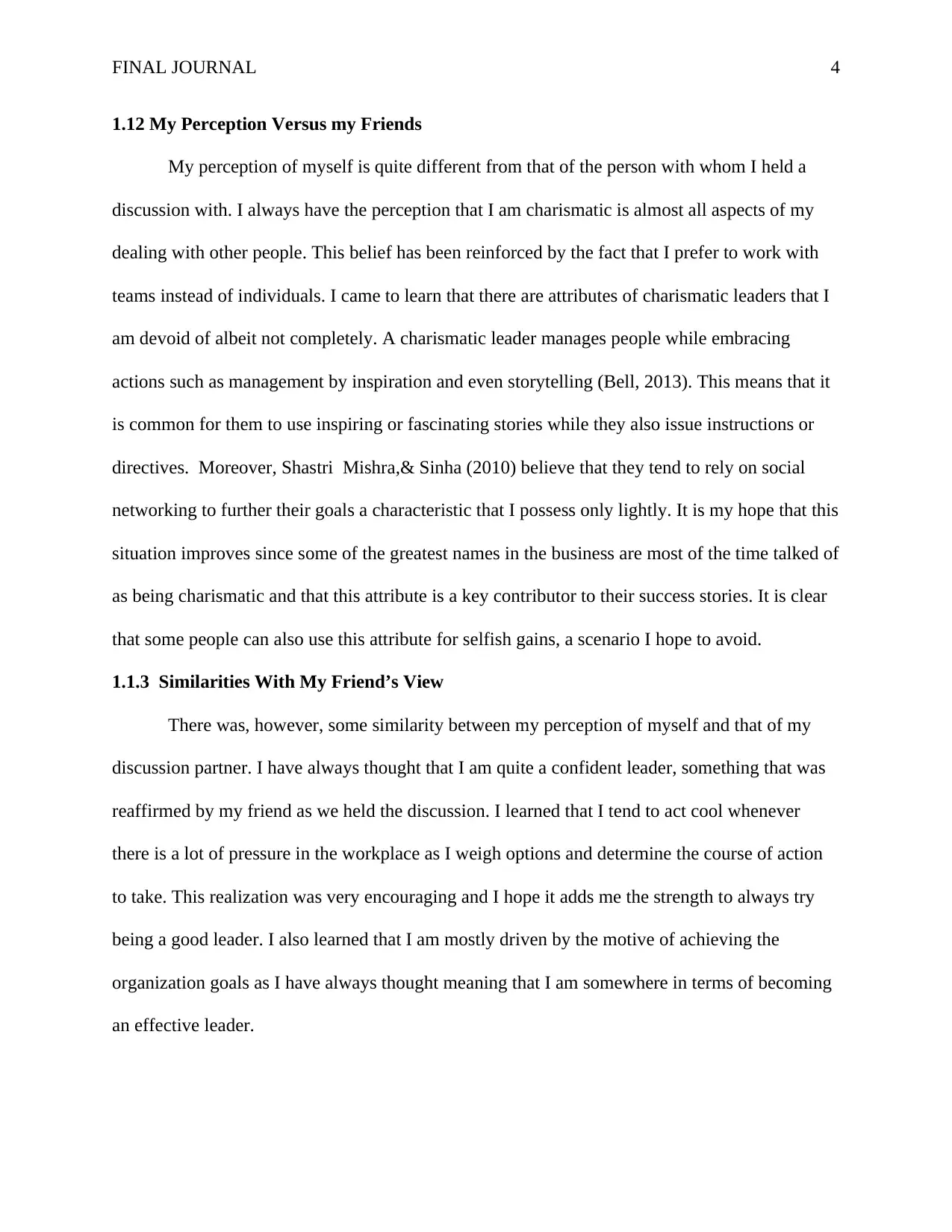
FINAL JOURNAL 4
1.12 My Perception Versus my Friends
My perception of myself is quite different from that of the person with whom I held a
discussion with. I always have the perception that I am charismatic is almost all aspects of my
dealing with other people. This belief has been reinforced by the fact that I prefer to work with
teams instead of individuals. I came to learn that there are attributes of charismatic leaders that I
am devoid of albeit not completely. A charismatic leader manages people while embracing
actions such as management by inspiration and even storytelling (Bell, 2013). This means that it
is common for them to use inspiring or fascinating stories while they also issue instructions or
directives. Moreover, Shastri Mishra,& Sinha (2010) believe that they tend to rely on social
networking to further their goals a characteristic that I possess only lightly. It is my hope that this
situation improves since some of the greatest names in the business are most of the time talked of
as being charismatic and that this attribute is a key contributor to their success stories. It is clear
that some people can also use this attribute for selfish gains, a scenario I hope to avoid.
1.1.3 Similarities With My Friend’s View
There was, however, some similarity between my perception of myself and that of my
discussion partner. I have always thought that I am quite a confident leader, something that was
reaffirmed by my friend as we held the discussion. I learned that I tend to act cool whenever
there is a lot of pressure in the workplace as I weigh options and determine the course of action
to take. This realization was very encouraging and I hope it adds me the strength to always try
being a good leader. I also learned that I am mostly driven by the motive of achieving the
organization goals as I have always thought meaning that I am somewhere in terms of becoming
an effective leader.
1.12 My Perception Versus my Friends
My perception of myself is quite different from that of the person with whom I held a
discussion with. I always have the perception that I am charismatic is almost all aspects of my
dealing with other people. This belief has been reinforced by the fact that I prefer to work with
teams instead of individuals. I came to learn that there are attributes of charismatic leaders that I
am devoid of albeit not completely. A charismatic leader manages people while embracing
actions such as management by inspiration and even storytelling (Bell, 2013). This means that it
is common for them to use inspiring or fascinating stories while they also issue instructions or
directives. Moreover, Shastri Mishra,& Sinha (2010) believe that they tend to rely on social
networking to further their goals a characteristic that I possess only lightly. It is my hope that this
situation improves since some of the greatest names in the business are most of the time talked of
as being charismatic and that this attribute is a key contributor to their success stories. It is clear
that some people can also use this attribute for selfish gains, a scenario I hope to avoid.
1.1.3 Similarities With My Friend’s View
There was, however, some similarity between my perception of myself and that of my
discussion partner. I have always thought that I am quite a confident leader, something that was
reaffirmed by my friend as we held the discussion. I learned that I tend to act cool whenever
there is a lot of pressure in the workplace as I weigh options and determine the course of action
to take. This realization was very encouraging and I hope it adds me the strength to always try
being a good leader. I also learned that I am mostly driven by the motive of achieving the
organization goals as I have always thought meaning that I am somewhere in terms of becoming
an effective leader.
Paraphrase This Document
Need a fresh take? Get an instant paraphrase of this document with our AI Paraphraser
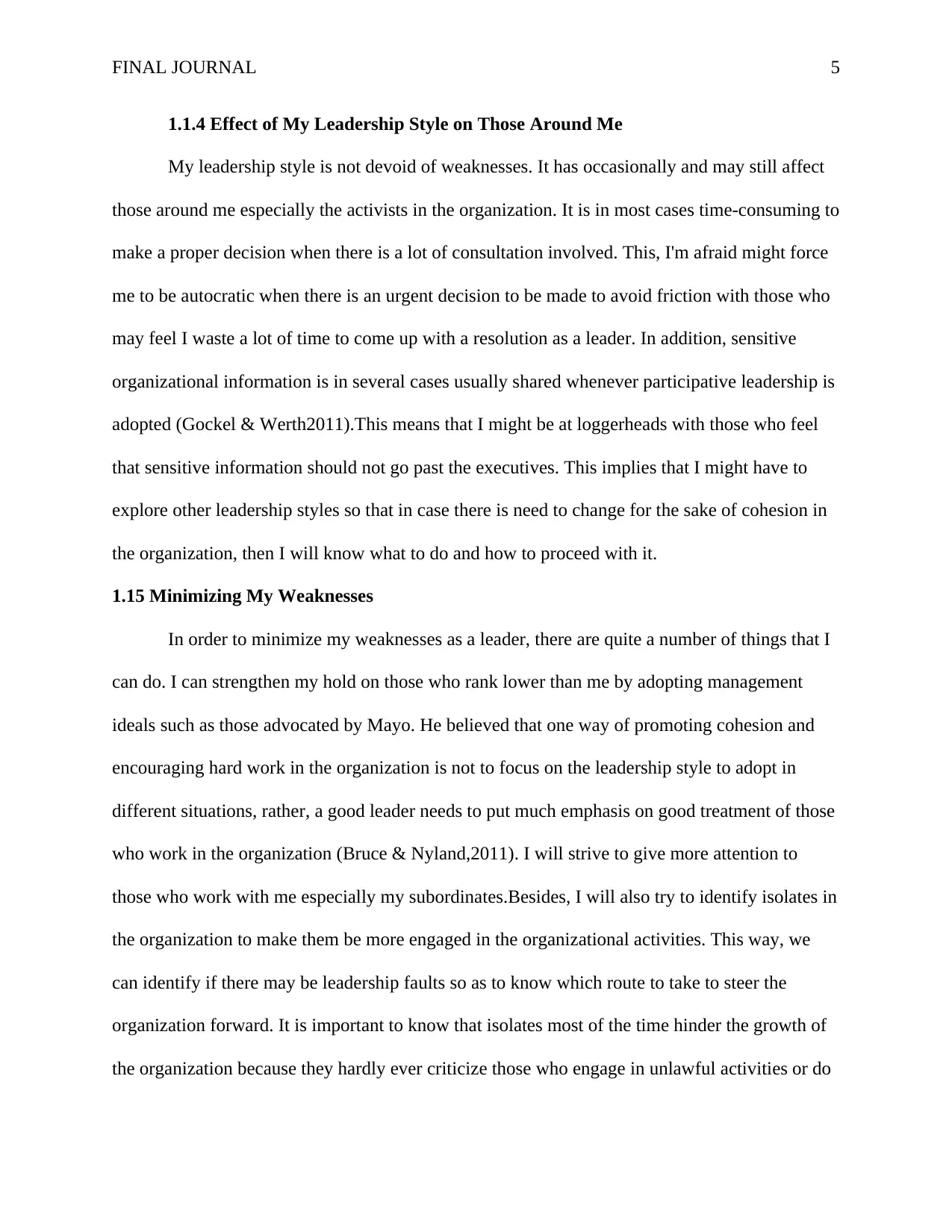
FINAL JOURNAL 5
1.1.4 Effect of My Leadership Style on Those Around Me
My leadership style is not devoid of weaknesses. It has occasionally and may still affect
those around me especially the activists in the organization. It is in most cases time-consuming to
make a proper decision when there is a lot of consultation involved. This, I'm afraid might force
me to be autocratic when there is an urgent decision to be made to avoid friction with those who
may feel I waste a lot of time to come up with a resolution as a leader. In addition, sensitive
organizational information is in several cases usually shared whenever participative leadership is
adopted (Gockel & Werth2011).This means that I might be at loggerheads with those who feel
that sensitive information should not go past the executives. This implies that I might have to
explore other leadership styles so that in case there is need to change for the sake of cohesion in
the organization, then I will know what to do and how to proceed with it.
1.15 Minimizing My Weaknesses
In order to minimize my weaknesses as a leader, there are quite a number of things that I
can do. I can strengthen my hold on those who rank lower than me by adopting management
ideals such as those advocated by Mayo. He believed that one way of promoting cohesion and
encouraging hard work in the organization is not to focus on the leadership style to adopt in
different situations, rather, a good leader needs to put much emphasis on good treatment of those
who work in the organization (Bruce & Nyland,2011). I will strive to give more attention to
those who work with me especially my subordinates.Besides, I will also try to identify isolates in
the organization to make them be more engaged in the organizational activities. This way, we
can identify if there may be leadership faults so as to know which route to take to steer the
organization forward. It is important to know that isolates most of the time hinder the growth of
the organization because they hardly ever criticize those who engage in unlawful activities or do
1.1.4 Effect of My Leadership Style on Those Around Me
My leadership style is not devoid of weaknesses. It has occasionally and may still affect
those around me especially the activists in the organization. It is in most cases time-consuming to
make a proper decision when there is a lot of consultation involved. This, I'm afraid might force
me to be autocratic when there is an urgent decision to be made to avoid friction with those who
may feel I waste a lot of time to come up with a resolution as a leader. In addition, sensitive
organizational information is in several cases usually shared whenever participative leadership is
adopted (Gockel & Werth2011).This means that I might be at loggerheads with those who feel
that sensitive information should not go past the executives. This implies that I might have to
explore other leadership styles so that in case there is need to change for the sake of cohesion in
the organization, then I will know what to do and how to proceed with it.
1.15 Minimizing My Weaknesses
In order to minimize my weaknesses as a leader, there are quite a number of things that I
can do. I can strengthen my hold on those who rank lower than me by adopting management
ideals such as those advocated by Mayo. He believed that one way of promoting cohesion and
encouraging hard work in the organization is not to focus on the leadership style to adopt in
different situations, rather, a good leader needs to put much emphasis on good treatment of those
who work in the organization (Bruce & Nyland,2011). I will strive to give more attention to
those who work with me especially my subordinates.Besides, I will also try to identify isolates in
the organization to make them be more engaged in the organizational activities. This way, we
can identify if there may be leadership faults so as to know which route to take to steer the
organization forward. It is important to know that isolates most of the time hinder the growth of
the organization because they hardly ever criticize those who engage in unlawful activities or do
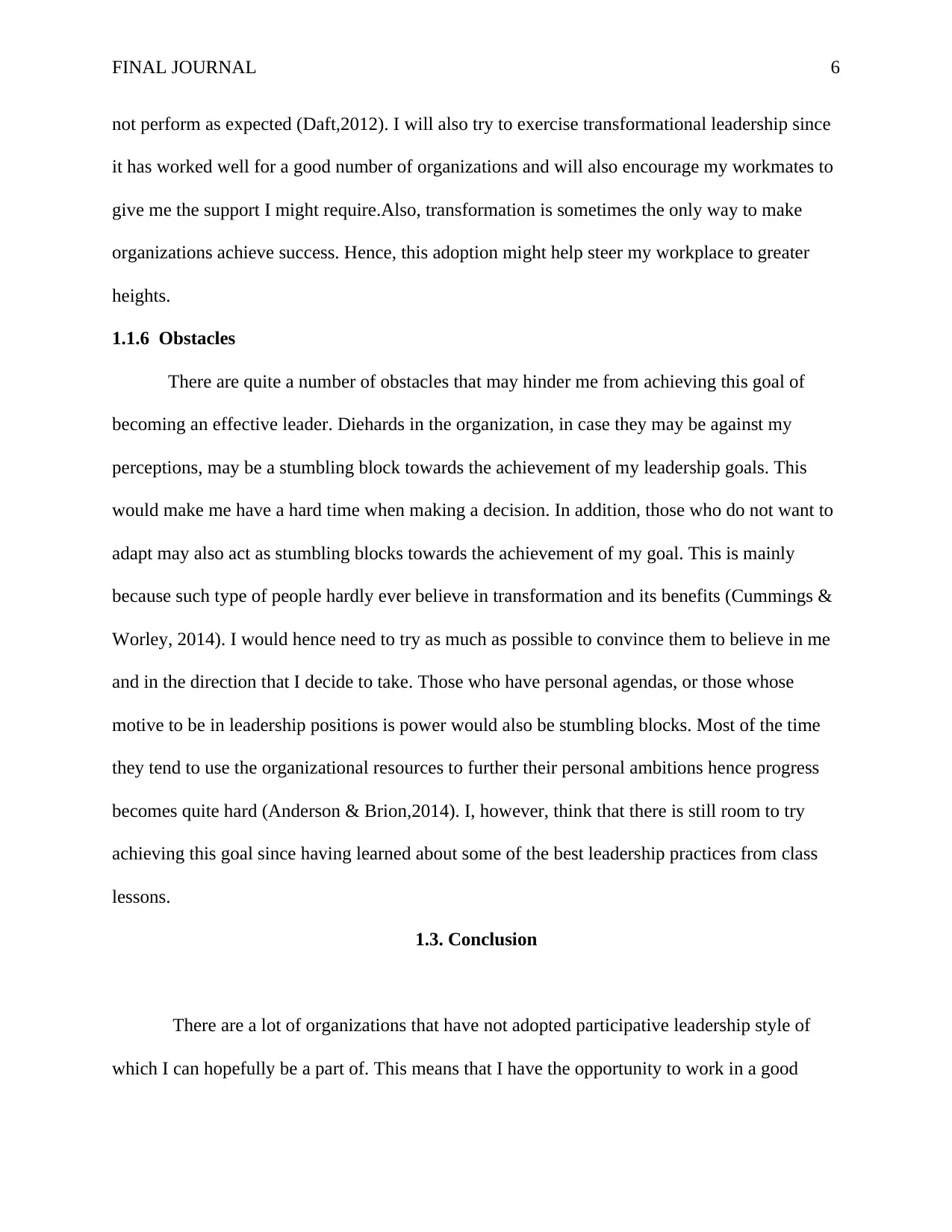
FINAL JOURNAL 6
not perform as expected (Daft,2012). I will also try to exercise transformational leadership since
it has worked well for a good number of organizations and will also encourage my workmates to
give me the support I might require.Also, transformation is sometimes the only way to make
organizations achieve success. Hence, this adoption might help steer my workplace to greater
heights.
1.1.6 Obstacles
There are quite a number of obstacles that may hinder me from achieving this goal of
becoming an effective leader. Diehards in the organization, in case they may be against my
perceptions, may be a stumbling block towards the achievement of my leadership goals. This
would make me have a hard time when making a decision. In addition, those who do not want to
adapt may also act as stumbling blocks towards the achievement of my goal. This is mainly
because such type of people hardly ever believe in transformation and its benefits (Cummings &
Worley, 2014). I would hence need to try as much as possible to convince them to believe in me
and in the direction that I decide to take. Those who have personal agendas, or those whose
motive to be in leadership positions is power would also be stumbling blocks. Most of the time
they tend to use the organizational resources to further their personal ambitions hence progress
becomes quite hard (Anderson & Brion,2014). I, however, think that there is still room to try
achieving this goal since having learned about some of the best leadership practices from class
lessons.
1.3. Conclusion
There are a lot of organizations that have not adopted participative leadership style of
which I can hopefully be a part of. This means that I have the opportunity to work in a good
not perform as expected (Daft,2012). I will also try to exercise transformational leadership since
it has worked well for a good number of organizations and will also encourage my workmates to
give me the support I might require.Also, transformation is sometimes the only way to make
organizations achieve success. Hence, this adoption might help steer my workplace to greater
heights.
1.1.6 Obstacles
There are quite a number of obstacles that may hinder me from achieving this goal of
becoming an effective leader. Diehards in the organization, in case they may be against my
perceptions, may be a stumbling block towards the achievement of my leadership goals. This
would make me have a hard time when making a decision. In addition, those who do not want to
adapt may also act as stumbling blocks towards the achievement of my goal. This is mainly
because such type of people hardly ever believe in transformation and its benefits (Cummings &
Worley, 2014). I would hence need to try as much as possible to convince them to believe in me
and in the direction that I decide to take. Those who have personal agendas, or those whose
motive to be in leadership positions is power would also be stumbling blocks. Most of the time
they tend to use the organizational resources to further their personal ambitions hence progress
becomes quite hard (Anderson & Brion,2014). I, however, think that there is still room to try
achieving this goal since having learned about some of the best leadership practices from class
lessons.
1.3. Conclusion
There are a lot of organizations that have not adopted participative leadership style of
which I can hopefully be a part of. This means that I have the opportunity to work in a good
⊘ This is a preview!⊘
Do you want full access?
Subscribe today to unlock all pages.

Trusted by 1+ million students worldwide
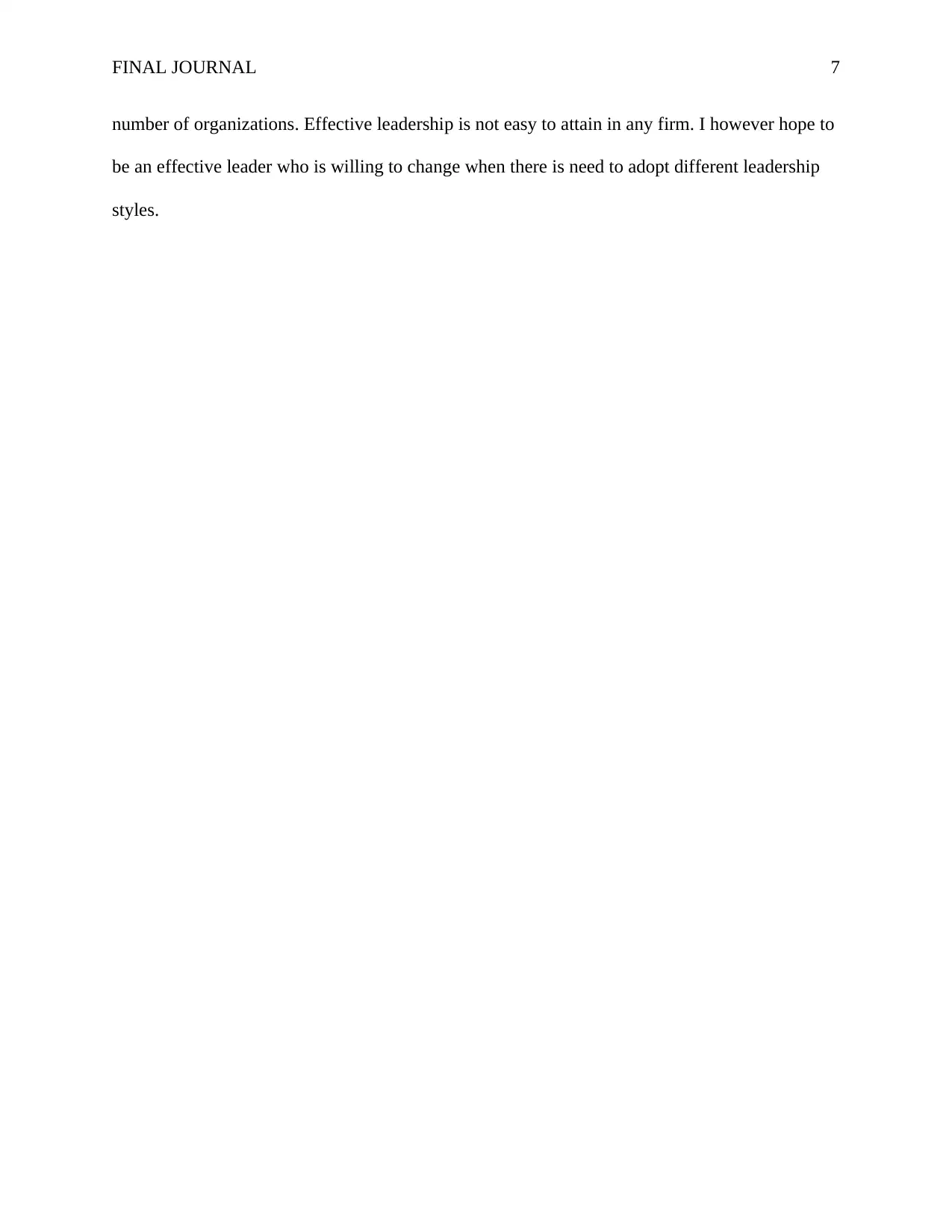
FINAL JOURNAL 7
number of organizations. Effective leadership is not easy to attain in any firm. I however hope to
be an effective leader who is willing to change when there is need to adopt different leadership
styles.
number of organizations. Effective leadership is not easy to attain in any firm. I however hope to
be an effective leader who is willing to change when there is need to adopt different leadership
styles.
Paraphrase This Document
Need a fresh take? Get an instant paraphrase of this document with our AI Paraphraser
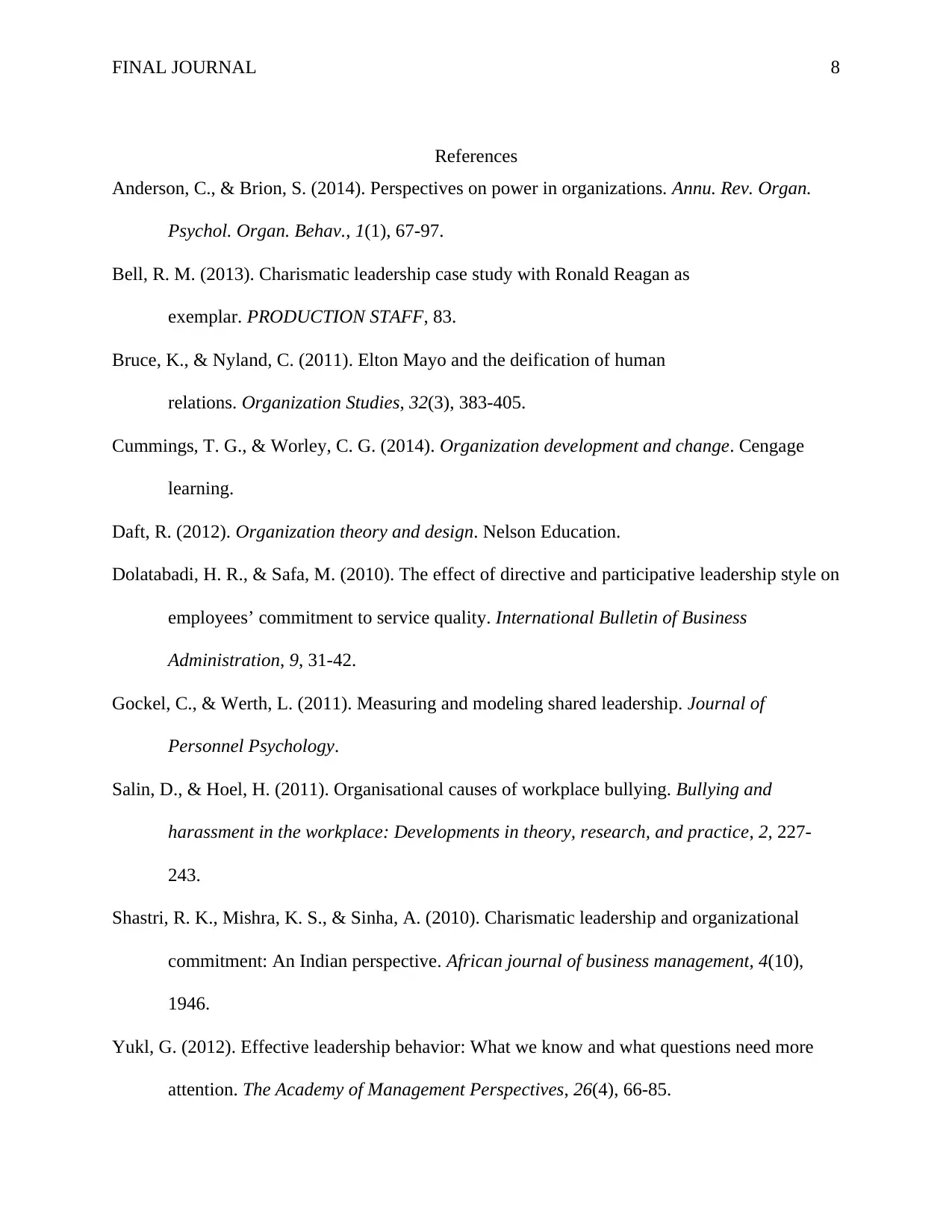
FINAL JOURNAL 8
References
Anderson, C., & Brion, S. (2014). Perspectives on power in organizations. Annu. Rev. Organ.
Psychol. Organ. Behav., 1(1), 67-97.
Bell, R. M. (2013). Charismatic leadership case study with Ronald Reagan as
exemplar. PRODUCTION STAFF, 83.
Bruce, K., & Nyland, C. (2011). Elton Mayo and the deification of human
relations. Organization Studies, 32(3), 383-405.
Cummings, T. G., & Worley, C. G. (2014). Organization development and change. Cengage
learning.
Daft, R. (2012). Organization theory and design. Nelson Education.
Dolatabadi, H. R., & Safa, M. (2010). The effect of directive and participative leadership style on
employees’ commitment to service quality. International Bulletin of Business
Administration, 9, 31-42.
Gockel, C., & Werth, L. (2011). Measuring and modeling shared leadership. Journal of
Personnel Psychology.
Salin, D., & Hoel, H. (2011). Organisational causes of workplace bullying. Bullying and
harassment in the workplace: Developments in theory, research, and practice, 2, 227-
243.
Shastri, R. K., Mishra, K. S., & Sinha, A. (2010). Charismatic leadership and organizational
commitment: An Indian perspective. African journal of business management, 4(10),
1946.
Yukl, G. (2012). Effective leadership behavior: What we know and what questions need more
attention. The Academy of Management Perspectives, 26(4), 66-85.
References
Anderson, C., & Brion, S. (2014). Perspectives on power in organizations. Annu. Rev. Organ.
Psychol. Organ. Behav., 1(1), 67-97.
Bell, R. M. (2013). Charismatic leadership case study with Ronald Reagan as
exemplar. PRODUCTION STAFF, 83.
Bruce, K., & Nyland, C. (2011). Elton Mayo and the deification of human
relations. Organization Studies, 32(3), 383-405.
Cummings, T. G., & Worley, C. G. (2014). Organization development and change. Cengage
learning.
Daft, R. (2012). Organization theory and design. Nelson Education.
Dolatabadi, H. R., & Safa, M. (2010). The effect of directive and participative leadership style on
employees’ commitment to service quality. International Bulletin of Business
Administration, 9, 31-42.
Gockel, C., & Werth, L. (2011). Measuring and modeling shared leadership. Journal of
Personnel Psychology.
Salin, D., & Hoel, H. (2011). Organisational causes of workplace bullying. Bullying and
harassment in the workplace: Developments in theory, research, and practice, 2, 227-
243.
Shastri, R. K., Mishra, K. S., & Sinha, A. (2010). Charismatic leadership and organizational
commitment: An Indian perspective. African journal of business management, 4(10),
1946.
Yukl, G. (2012). Effective leadership behavior: What we know and what questions need more
attention. The Academy of Management Perspectives, 26(4), 66-85.
1 out of 8
Related Documents
Your All-in-One AI-Powered Toolkit for Academic Success.
+13062052269
info@desklib.com
Available 24*7 on WhatsApp / Email
![[object Object]](/_next/static/media/star-bottom.7253800d.svg)
Unlock your academic potential
Copyright © 2020–2025 A2Z Services. All Rights Reserved. Developed and managed by ZUCOL.





